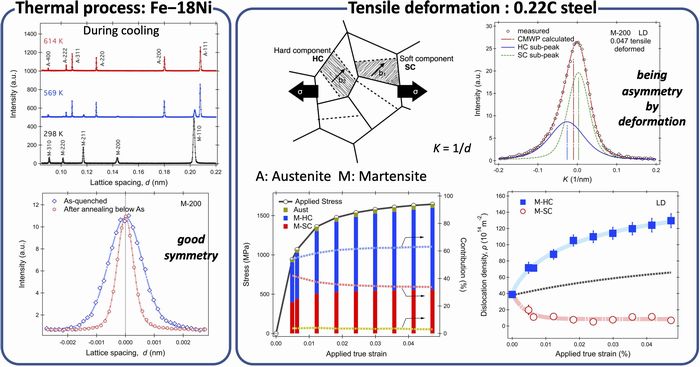Volume 62, Issue 10
Special Issue on "Strength, Plasticity, and Fracture in Steels: Towards Quantitative Bridging of Experiment and Simulation"
Displaying 1-26 of 26 articles from this issue
- |<
- <
- 1
- >
- >|
Publication Data
-
2022 Volume 62 Issue 10 Pages Cover-
Published: October 15, 2022
Released on J-STAGE: October 19, 2022
Download PDF (407K) -
2022 Volume 62 Issue 10 Pages Editorial-
Published: October 15, 2022
Released on J-STAGE: October 19, 2022
Download PDF (469K) -
2022 Volume 62 Issue 10 Pages Contents-
Published: October 15, 2022
Released on J-STAGE: October 19, 2022
Download PDF (203K)
Special Issue on "Strength, Plasticity, and Fracture in Steels: Towards Quantitative Bridging of Experiment and Simulation"
Preface
-
Article type: Preface
2022 Volume 62 Issue 10 Pages 1971
Published: October 15, 2022
Released on J-STAGE: October 19, 2022
Download PDF (210K) Full view HTML
Regular Article
-
Article type: Regular Article
2022 Volume 62 Issue 10 Pages 1972-1980
Published: October 15, 2022
Released on J-STAGE: October 19, 2022
Download PDF (2516K) Full view HTML -
Article type: Regular Article
2022 Volume 62 Issue 10 Pages 1981-1989
Published: October 15, 2022
Released on J-STAGE: October 19, 2022
Download PDF (957K) Full view HTML -
Article type: Regular Article
2022 Volume 62 Issue 10 Pages 1990-1999
Published: October 15, 2022
Released on J-STAGE: October 19, 2022
Advance online publication: August 25, 2022Download PDF (1758K) Full view HTML -
Article type: Regular Article
2022 Volume 62 Issue 10 Pages 2000-2007
Published: October 15, 2022
Released on J-STAGE: October 19, 2022
Advance online publication: August 27, 2022Download PDF (1254K) Full view HTML -
Article type: Regular Article
2022 Volume 62 Issue 10 Pages 2008-2015
Published: October 15, 2022
Released on J-STAGE: October 19, 2022
Download PDF (1749K) Full view HTML -
Article type: Regular Article
2022 Volume 62 Issue 10 Pages 2016-2024
Published: October 15, 2022
Released on J-STAGE: October 19, 2022
Download PDF (1716K) Full view HTML -
Article type: Regular Article
2022 Volume 62 Issue 10 Pages 2025-2035
Published: October 15, 2022
Released on J-STAGE: October 19, 2022
Download PDF (2921K) Full view HTML -
Article type: Regular Article
2022 Volume 62 Issue 10 Pages 2036-2042
Published: October 15, 2022
Released on J-STAGE: October 19, 2022
Advance online publication: February 03, 2022Download PDF (1896K) Full view HTML -
Article type: Regular Article
2022 Volume 62 Issue 10 Pages 2043-2053
Published: October 15, 2022
Released on J-STAGE: October 19, 2022
Advance online publication: June 03, 2022Download PDF (2889K) Full view HTML -
Article type: Regular Article
2022 Volume 62 Issue 10 Pages 2054-2060
Published: October 15, 2022
Released on J-STAGE: October 19, 2022
Download PDF (1607K) Full view HTML -
Article type: Regular Article
2022 Volume 62 Issue 10 Pages 2061-2068
Published: October 15, 2022
Released on J-STAGE: October 19, 2022
Advance online publication: May 28, 2022Download PDF (2693K) Full view HTML -
Article type: Regular Article
2022 Volume 62 Issue 10 Pages 2069-2073
Published: October 15, 2022
Released on J-STAGE: October 19, 2022
Download PDF (1605K) Full view HTML
Review Article
-
Article type: Review
2022 Volume 62 Issue 10 Pages 2074-2080
Published: October 15, 2022
Released on J-STAGE: October 19, 2022
Download PDF (1237K) Full view HTML
Regular Article
-
Article type: Regular Article
2022 Volume 62 Issue 10 Pages 2081-2088
Published: October 15, 2022
Released on J-STAGE: October 19, 2022
Download PDF (1688K) Full view HTML -
Article type: Regular Article
2022 Volume 62 Issue 10 Pages 2089-2094
Published: October 15, 2022
Released on J-STAGE: October 19, 2022
Advance online publication: July 06, 2022Download PDF (1673K) Full view HTML -
Article type: Regular Article
2022 Volume 62 Issue 10 Pages 2095-2106
Published: October 15, 2022
Released on J-STAGE: October 19, 2022
Download PDF (2744K) Full view HTML -
Article type: Regular Article
2022 Volume 62 Issue 10 Pages 2107-2117
Published: October 15, 2022
Released on J-STAGE: October 19, 2022
Download PDF (1767K) Full view HTML -
Article type: Regular Article
2022 Volume 62 Issue 10 Pages 2118-2125
Published: October 15, 2022
Released on J-STAGE: October 19, 2022
Advance online publication: June 01, 2022Download PDF (1569K) Full view HTML -
Article type: Regular Article
2022 Volume 62 Issue 10 Pages 2126-2131
Published: October 15, 2022
Released on J-STAGE: October 19, 2022
Download PDF (1871K) Full view HTML
Note
-
Article type: Note
2022 Volume 62 Issue 10 Pages 2132-2134
Published: October 15, 2022
Released on J-STAGE: October 19, 2022
Download PDF (841K) Full view HTML
Regular Article
-
Article type: Regular Article
2022 Volume 62 Issue 10 Pages 2135-2146
Published: October 15, 2022
Released on J-STAGE: October 19, 2022
Download PDF (5837K) Full view HTML -
Article type: Regular Article
2022 Volume 62 Issue 10 Pages 2147-2157
Published: October 15, 2022
Released on J-STAGE: October 19, 2022
Advance online publication: March 28, 2022Download PDF (2511K) Full view HTML
- |<
- <
- 1
- >
- >|











 ) but tensile strength (TS) indicated almost the same value at
) but tensile strength (TS) indicated almost the same value at 










